Tracking Survivors With Long COVID: Method, Implementation, and Results of an Observational Study
- PMID: 39764743
- PMCID: PMC11873753
- DOI: 10.1002/nur.22437
Tracking Survivors With Long COVID: Method, Implementation, and Results of an Observational Study
Abstract
While the coronavirus disease 2019 (COVID-19) pandemic has declined, many survivors continue to suffer debilitating symptoms, such as fatigue, pain, and foggy thoughts. Sustained COVID-19 symptoms, or Long COVID, challenge health care resources and economic recovery. This article describes the methodology, implementation, and results of an observational study investigating how time since diagnosis may affect lingering symptoms among the adult COVID-19 population. The descriptive distribution and overall symptoms experience by individuals' characteristics were examined. Random samples from two patient cohorts (n = 147 in 2020-2021 and n = 137 in 2021-2022) were recruited from a COVID-19 patient registry in mid-Michigan. Samples were drawn from a pool of patients ≥ 3 months following their COVID-19 diagnosis. Overall symptoms experience (number, severity, interference) was self-reported using a comprehensive symptom inventory. The findings showed that 66% of the 2020-2021 cohort and 47% of the 2021-2022 cohort reported ≥ 1 lingering symptom with an average of 11.2 (±3.0) and 8.9 (±3.3) months, respectively, after COVID-19 diagnosis. Females reported significantly more symptoms (p = 0.018), higher symptom severity (p = 0.008) and interference (p = 0.007) compared to males. Compared to patients admitted to emergency departments, outpatients reported significantly lower symptom severity (p = 0.020) and less symptom interference (p = 0.018). Our analyses showed that a moderate proportion (43%) of adults remained symptomatic nearly a year after COVID-19 infection and time since diagnosis did not affect symptom experience in either cohort. Female sex and admission setting are important factors to consider for managing and studying Long COVID.
Keywords: COVID‐19; SARS‑CoV‑2 infection; long COVID, post‐acute COVID‐19 syndrome.
© 2025 The Author(s). Research in Nursing & Health published by Wiley Periodicals LLC.
Conflict of interest statement
The authors declare no conflicts of interest.
Figures



Similar articles
-
Estimated Global Proportions of Individuals With Persistent Fatigue, Cognitive, and Respiratory Symptom Clusters Following Symptomatic COVID-19 in 2020 and 2021.JAMA. 2022 Oct 25;328(16):1604-1615. doi: 10.1001/jama.2022.18931. JAMA. 2022. PMID: 36215063 Free PMC article.
-
Persistent symptoms and clinical findings in adults with post-acute sequelae of COVID-19/post-COVID-19 syndrome in the second year after acute infection: A population-based, nested case-control study.PLoS Med. 2025 Jan 23;22(1):e1004511. doi: 10.1371/journal.pmed.1004511. eCollection 2025 Jan. PLoS Med. 2025. PMID: 39847575 Free PMC article.
-
Health outcomes in people 2 years after surviving hospitalisation with COVID-19: a longitudinal cohort study.Lancet Respir Med. 2022 Sep;10(9):863-876. doi: 10.1016/S2213-2600(22)00126-6. Epub 2022 May 11. Lancet Respir Med. 2022. PMID: 35568052 Free PMC article.
-
Assessment of the Frequency and Variety of Persistent Symptoms Among Patients With COVID-19: A Systematic Review.JAMA Netw Open. 2021 May 3;4(5):e2111417. doi: 10.1001/jamanetworkopen.2021.11417. JAMA Netw Open. 2021. PMID: 34037731 Free PMC article.
-
Universal screening for SARS-CoV-2 infection: a rapid review.Cochrane Database Syst Rev. 2020 Sep 15;9(9):CD013718. doi: 10.1002/14651858.CD013718. Cochrane Database Syst Rev. 2020. PMID: 33502003 Free PMC article.
References
-
- Admon, A. J. , Iwashyna T. J., and Kamphuis L. A., et al. 2023. “Assessment of Symptom, Disabiliy, and Financial Trajectories in Patients Hospitalized for COVID‐19 at 6 Months.” Journal of American Medical Association Network Open 6, no. 2: e2255795. 10.1001/jamanetworkopen.2022.55795. - DOI - PMC - PubMed
Publication types
MeSH terms
Grants and funding
LinkOut - more resources
Full Text Sources
Medical
Miscellaneous
